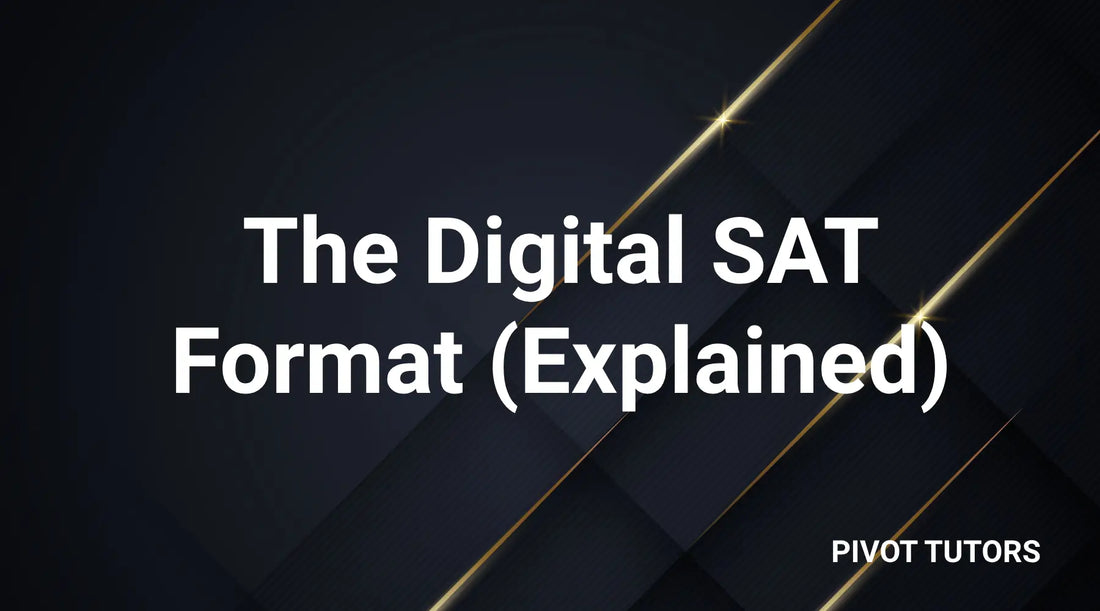In recent years, standardized testing has evolved, embracing digital formats to meet modern needs. The SAT, a critical component of college admissions, is no exception. As the test transitions from paper to pixels, students worldwide are adapting to the digital SAT — a change that brings new challenges and opportunities. This shift means students must not only master the content but also become adept at navigating the digital landscape of test-taking. Gone are the days of penciling in bubbles; welcome to the era of clicking and scrolling through questions.
Understanding and mastering digital test-taking strategies have become essential. It's not just about what you know; it's also about how you take the test. The shift to a computer-based format affects various aspects of the testing experience, from time management and reading comprehension to technical troubleshooting and stress management. In this post, we’ll dive into the format of the digital SAT. In future posts, we’ll look at strategies for optimizing your performance on the digital SAT.
Understanding the Digital SAT Format
The transition to the digital SAT marks a significant shift in how students interact with one of the most well-known standardized tests. Understanding the format is the first step in mastering the digital version. This section breaks down the structure, presents the question types, and discusses the overall design of the digital SAT, preparing you for what to expect on test day.
- Overview of the Digital Format:
- Structure and Sections: The digital SAT retains its core focus areas: Evidence-Based Reading and Writing, and Math. However, the way you will interact with these sections changes. Questions are presented one at a time on the screen, and navigation is done through clicks or keyboard commands, rather than flipping pages.
- Question Presentation: Instead of seeing all questions at once, digital test-takers will navigate through questions sequentially. This means focusing on one question at a time, potentially reducing the overwhelming feeling of lengthy reading passages or complex problems.
- Question Types and Interaction:
- Multiple Choice: Just like the traditional format, most questions are multiple choice, but instead of filling circles, you'll be clicking your answers.
- Grid-Ins for Math: For math sections, some answers will require entering numbers or calculations directly into a grid. Familiarity with the digital interface for these types of questions is crucial.
- Adaptive Nature: One of the significant changes in the digital SAT is its adaptive nature. The difficulty of the second section of each subject is determined by your performance in the first, making it crucial to give each question your utmost attention.
- Timing and Breaks:
- Pacing: Each section is timed, and the digital format offers a visible timer on the screen. This can be an advantage in managing your pace throughout the test.
- Scheduled Breaks: Breaks are given between sections, just like in the traditional test. However, with the digital format, it's easier to know exactly when breaks occur thanks to on-screen notifications.
- On-Screen Features and Tools:
- Navigational Buttons: Learn how to use forward, backward, and mark buttons effectively. While you can't skip back and forth between sections, you can navigate questions within a section.
- Review Screen: A feature often allows you to review which questions you've completed and which you've marked to return to before finalizing a section.
- Calculator and Notes: For applicable sections, an on-screen calculator and note-taking area are provided. Knowing how to use these can save valuable time.
- Accessibility and Accommodations:
- Adjustable Settings: The digital format can accommodate different needs, including adjustable text size and screen contrast.
- Accommodations for Disabilities: Additional time, breaks, or other necessary accommodations continue to be available, ensuring that all students have equitable access to the test.
Understanding the digital SAT format is about more than just knowing the type of questions you'll face. It's about familiarizing yourself with the digital environment, the tools at your disposal, and the strategies that will enable you to navigate this new testing landscape effectively. By comprehending the structure and functionality of the digital SAT, you'll be better prepared to tackle the test confidently and efficiently.

